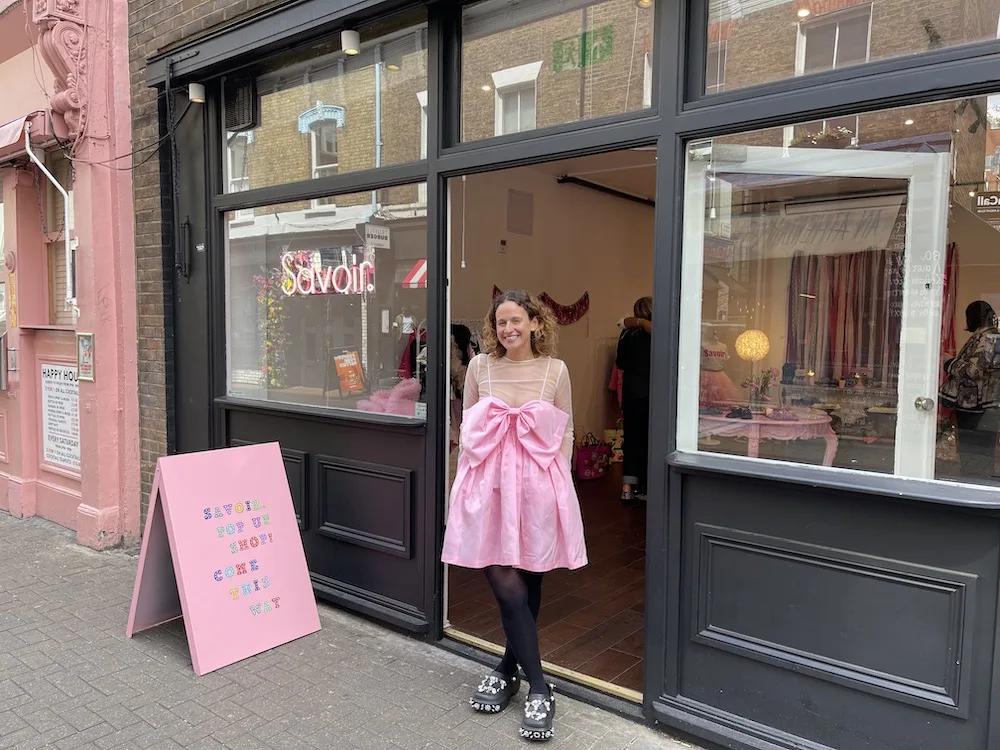Arguably one of the most beautiful and evocative places in history, Venice is visited by millions but discovered by the very few. Our Editor-in-Chief, Julia Pasarón, takes us on a tour of her favourite places, which encapsulate the exquisite skill and craftmanship that made Venice the queen of luxury trade for centuries. Today, they are kept alive by independent ateliers that pepper its seductive streets and winding canals.
Having grown up within a family of art lovers, it is no surprise that in my childhood, I dreamt of going to Venice as much as other children dream of going to Disneyland. I’ve been lucky enough to visit this incredible city several times in my life. On this occasion, I travelled with my sister and chose to go completely off-grid, with the help of a local friend and that of Salvatore “Salva” Pisani, General Manager at the Splendid Venice, the hotel where we stayed.


Splendid Venice – Starhotels Collezione: canal entrance and lounge area.
It’s a pink building, like many others in Venice, but tucked behind the inconspicuous façade – close to St. Mark’s Square and the Rialto Bridge – is its canal entrance: the first feeling of fineness that lies behind the doors of the Splendid. Here, you find a private pier, where traditional gondolas and water taxis drop off and pick up guests. Inside, the full character of the hotel reveals itself. I was greeted by Salva at the Lounge Bar, a sumptuous space overlooking the canal, decorated with precious Murano glass chandeliers, refined furniture fabrics and large mirrors. Over cocktails, he gave me a few tips about where to go and what to do in his neck of the woods. Among them, the Palazzo Contarini del Bovolo, built in the 15th century as one of the city residences of the Contarini family. “Bovolo” (Italian for snail) refers to its external, multi-arch spiral staircase. Made of red brick and white stone, this beautiful structure spans six floors and is 28 metres high. Those who make it to the top are rewarded with spectacular views of the dome and campanile of St. Mark’s Basilica.


The Palazzo Contarini del Bovolo, commissioned in 1499 by Pietro Contarini. Its design is thought to have been the creation of either local master builder Giovanni Candi or the architect Giorgio Spavento.
In Cannaregio, the northernmost district of Venice, we find another gem often missed by tourists: the 14th century church of the Madonna dell’Orto, where Tintoretto’s ashes rest. The church is home to 11 paintings by the master. Totally jaw-dropping is the monumental pair, The Adoration of the Golden Calf and The Last Judgement (circa 1563), that flanks the altar. They fit exactly into their spaces, which probably means they were painted in situ.
The name of the church comes from a curious story. Originally it was dedicated to Saint Christopher, patron saint of the gondoliers. The parish priest of Santa Maria de la Formosa (a gorgeous example of renaissance architecture) commissioned Giovanni de Santi to make a sculpture of the Virgin Mary but didn’t like it – so the piece ended up in the artist’s orchard (orto). Legend has it that the statue started to glow in the dark and was responsible for miracles. Soon, the garden became a destination for pilgrims, and the bishop asked de Santi to donate it to a public church. Obligingly, he offered it to St. Christopher, in 1377.


Interior of the Church of the Madonna dell’Orto showing Tintoretto’s The Adoration of the Golden Calf and The Last Judgement (circa 1563), and the statue that started the legend.
A few minutes away is Bottega del Tintoretto, an artisan graphics atelier on the site of Tintoretto’s original workshop. Using antique equipment restored under the loving eye of director, Roberto Mazzetto, artists at the Bottega – or Stamperia as it is also known – can make their own lithographs, reliefs, silkscreen prints… Mr Mazzetto and his team of volunteers are always on hand to help, and run regular courses for locals and visitors alike. Imagine learning papermaking, typography or fresco painting in the same place where Tintoretto used to work. From one homage to craftmanship to another. Because of its crucial role in the trade between East and West since the Middle Ages, all kinds of fragrant oils, resins and spices were available to Venetian perfumiers, soap makers and producers of cosmetics. Murano artisans then created exquisite bottles and phials for these products, which became highly sought-after by all the European court. As a result, their popularity exploded.


Left: At Bottega del Tintoretto, visitors can learn the ancient skills of lithography, binding and silkscreen printing among other ancient skills lovingly kept alive by Mr Mazzetto and his team. Right: Detail of the Merchant of Venice store, a few minutes from St Mark’s Basilica
Owned by the Vidal family, The Merchant of Venice is a luxury company that echoes the ancient art of Venetian perfumery, whose history you can learn at the aristocratic Palazzo Mocenigo. Their products, bottled in exquisite Venetian glass, range from precious fragrances based on age-old recipes to innovative propositions created by the master perfumiers that work with the Vidals. They run courses and workshops that bring enthusiasts, connoisseurs and the simply curious into the fascinating world of perfume creation.
One can’t leave Cannaregio without dining at Il Paradiso Perduto, a very cool osteria and jazz club established in the 1980s by university students. The menu pretty much changes every day, reflecting the freshest produce that chef Adamo finds in the market; but in general, the cuisine is traditional Venetian. The signature dish is il gran fritoin, assorted fried fish accompanied by white polenta.


Splendid Venice – Starhotels Collezione: Heritage Suite and Altana roof terrace.
With bellies full of delicious seafood and heads slightly intoxicated by Valpolicella, we made our way back to the hotel, but before going to our suite, we couldn’t resist having a last drink on the Altana, the rooftop terrace at the Splendid, which looks particularly magic at night, with its 360° view that stretches for miles.
Having decided to focus this trip on exploring the rich tapestry of craftmanship embedded in the DNA of Venice, we turned our attention to textiles, which helped the city become the absolute queen of luxury trade from the 13th to the 18th centuries. The best of everything would arrive in Venice before anywhere else in Europe, including silk. In 1265, the Samite Weavers Guild (Arte dei Samiteri) was set up, to produce samite, the richest silk fabric of the time. Velvety to the touch and with a satin finish, it was often interwoven with gold and silver threads. Used mainly to make clothes for royalty and holy vestments, samite would eventually evolve into the incomparable Venetian velvet.


Left: Tessitura Luigi Bevilacqua atelier where its velvet is produced in 18th century machines. Right: Tessitura Luigi Bevilacqua showroom and shop on the Grand Canal, Venice.
Tessitura Luigi Bevilacqua, founded by a family whose textile roots date back to the 15th century, is today the only weaver producing the precious “soprarizzo” velvet. Its manufacture is very complicated and is still carried out by skilled hands on 18th century machines, which previously belonged to the Samite Weavers Guild of Venice. The company has the most illustrious portfolio of clients, including Dolce & Gabbana, Fabergé, Stockholm’s City Hall and even the Basilica della Salute, here in Venice.
As unique as Tessitura Luigi Bevilacqua is Mario Berta Battiloro, who, to my knowledge, is the last remaining goldbeater in Europe. Mario has brought the family craft that started in 1926 into the 21st century. His gold and silver leaves are used not only in the world of art, but also in food and even in skincare and cosmetics, as gold has well-known anti-ageing properties. Battiloro produces its own range – MBB – which is used by many luxury beauty salons and spas. Their Splendor face kit and eye-patches have close to miraculous effects and it is becoming increasingly popular to wear Battiloro gold leaf on eyelids, lips and nails.



Battiloro’s gold leaf is not just used in art pieces but also in food and cosmetics.
For the “last supper” of our trip, my sister and I had dinner at Le Maschere, the restaurant at the Splendid. Chef Massimo Livan surprised with an imaginative menu that showed off the best of authentic Venetian cuisine and local ingredients. My favourite dish of the evening was the Lagoon prawns with soft, cornmeal polenta and samphire-like glasswort from Treporti, a little island off the Lido di Jesolo in Venice. The small crustacea, similar to shrimp, were once considered food for the poor, but chef Livan, has truly elevated them into the category of fine dining.

Le Maschere restaurant at the Splendid Venice, where Chef Massimo Levin shows off the best of Venetian cuisine. The retractable roof opens from late spring for long lazy al fresco lunches or dinners.
One always leaves Venice with a heavy heart, and this time was no different. However, something tells me that I’ll soon be back at the Serenissima, hoping to unveil more of its precious secrets.
British Airways flies from London to Venice from £46 each-way in Economy Class and from £139 each-way in Business Class. They also have special seasonal offers with BA EuroFlyer from London Gatwick.

















Show Comments +